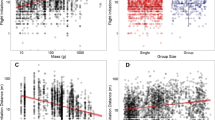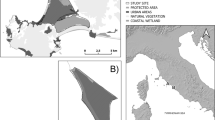Abstract
Human activity affects wildlife in many ways, but there have been few studies of how wildlife behavioural responses to human disturbance vary with distance from centres of human activity. Theory suggests that fear responses may be either higher in areas with high disturbance (disturbance avoidance) or lower in such areas (e.g. due to habituation). We used flight initiation distance (FID) to study how fear responses of 16 bird species varied with distance from villages (range 0.1–11.6 km) within the Ramsar site of Kilombero Valley, Tanzania. A linear model indicated that FID was not related to distance from villages, but varied between habitats. However, a piecewise linear model (linear response up to 2 km, flat response >2 km from villages) provided a better fit and suggested that there may be a small decrease in FID close to human settlements, in particular for the Common Bulbul (Pycnonotus barbatus) and a few other species, although the majority of species still showed little change in FID with distance from human settlements. Our results suggest that a few species may respond to human disturbance with a decreased FID, whereas the majority of species showed little variation in FID in relation to distance from human settlements, and may therefore be negatively affected by increasing frequency of human disturbance.
Zusammenfassung
Fluchtdistanzen von Vögeln in Beziehung zum Abstand von menschlichen Siedlungen in einer Überschwemmungsebene in Tansania
Menschliches Handeln beeinflusst Tiere auf vielerlei Arten, aber es gab nur wenige Untersuchungen, wie sich die Verhaltensantworten der Tiere auf Störung durch Menschen unterscheiden in Abhängigkeit vom Abstand zum Zentrum menschlichen Handelns. Die Theorie sagt, dass Angstreaktionen entweder höher sind in Gegenden mit viel Störungen (Störungsmeidung) oder niedriger (z.B. aufgrund von Habituation). Wir betrachteten Fluchtdistanzen von 16 Vogelarten im Kilombero-Tal, einem Ramsar-Gebiet in Tansania, um zu untersuchen, wie sich deren Angstreaktionen unterschieden in Abhängigkeit ihrer Distanz zu Ortschaften (im Bereich von 00.1 bis 11.6 km). Ein lineares Modell zeigte, dass es zwischen Fluchtdistanz und Abstand von Ortschaften keinen Zusammenhang gab, sondern sie sich mit dem Habitat änderte. Allerdings ergab ein piecewise linear Modell (linear bis zu 2 km, flach >2 km zu Ortschaften) eine bessere Anpassung und deutete darauf hin, dass es eine kleine Verringerung der Fluchtdistanz geben könnte in der Nähe von menschlichen Siedlungen, insbesondere für den Graubülbül (Pycnonotus barbatus) und für andere Arten, wobei die meisten Arten in Abhängigkeit vom Abstand zu menschlichen Siedlungen jedoch nur eine geringe Änderung in der Fluchtdistanz zeigten. Unsere Ergebnisse deuten darauf hin, dass einige wenige Arten auf menschliche Störungen mit einer Verringerung ihrer Fluchtdistanz reagieren, während der Großteil der Arten nur geringe Unterschiede in ihrer Fluchtdistanz zeigten, und daher negativ beeinflusst werden könnten durch eine Zunahme der Häufigkeit menschlicher Störungen.

Similar content being viewed by others
References
Beale CM, Monaghan P (2004) Behavioural responses to human disturbance: a matter of choice? Anim Behav 68:1065–1069
Bisson I-A, Butler LK, Hayden TJ, Romero LM, Wikelski MC (2009) No energetic cost of anthropogenic disturbance in a songbird. Proc R Soc Lond B 276:961–969
Blumstein DT (2006) Developing an evolutionary ecology of fear: how life history and natural history traits affect disturbance tolerance in birds. Anim Behav 71:389–399
Blumstein DT, Fernández-Juricic E, LeDee O, Larsen E, Rodriguez-Prieto I, Zugmeyer C (2004) Avian risk assessment: effects of perching height and detectability. Ethology 110:273–285
Blumstein DT, Fernández-Juricic E, Zollner PA, Garity SC (2005) Inter-specific variation in avian responses to human disturbance. J Appl Ecol 42:943–953
Bonnington C, Weaver D, Fanning E (2007) Livestock and large wild mammals in the Kilombero Valley, in southern Tanzania. Afr J Ecol 45:658–663
Carrete M, Tella JL (2010) Individual consistency in flight initiation distances in burrowing owls: a new hypothesis on disturbance-induced habitat selection. Biol Lett 6:167–170
Carrete M, Tella JL (2011) Inter-individual variability in fear of humans and relative brain size of the species are related to contemporary urban invasions in birds. PLoS ONE 6(4):e18859
Clucas B, Marzluff JM (2012) Attitudes and actions toward birds in urban areas: human cultural differences influence bird behaviour. Auk 129:8–16
Cooke AS (1980) Observations on how close certain passerine species will tolerate an approaching human in rural and suburban areas. Biol Conserv 18:85–88
Cooper WE, Frederick WG (2007) Optimal flight initiation distance. J Theor Biol 244:59–67
Evans J, Boudreau K, Hyman J (2010) Behavioural syndromes in urban and rural populations of song sparrows. Ethology 116:588–595
Fernández-Juricic E, Jimenez MD, Lucas E (2001) Alert distance as an alternative measure of bird tolerance to human disturbance: implications for park design. Environ Conserv 28:263–269
Fernández-Juricic E, Sallent A, Sanz R, Rodríguez-Prieto I (2003) Testing the risk-disturbance hypothesis in a fragmented landscape: nonlinear responses of house sparrows to humans. Condor 105:315–326
Fernández-Juricic E, Zahn EF, Parker T, Stankowich T (2009) California’s endangered Belding’s sparrow (Passerculus sandwichensis beldingi): tolerance of pedestrian disturbance. Avian Conserv Ecol 4(2):1
Frid A, Dill L (2002) Human-caused disturbance stimuli as a form of predation risk. Conserv Ecol 6(1):11
Fry CH, Keith S (2000) The birds of Africa, vol 6. Academic, London
Fry CH, Keith S (2004) The birds of Africa, vol 7. Academic, London
Fry CH, Keith S, Urban EK (1988) The birds of Africa, vol 3. Academic, London
Haule KS, Johnsen FH, Maganga SLS (2002) Striving for sustainable wildlife management: the case of Kilombero game controlled area, Tanzania. J Environ Manag 66:31–42
Jenkins RKB, Corti GR, Fanning E, Roettcher K (2002) Management implications of antelope habitat use in the Kilombero Valley, Tanzania. Oryx 36:161–169
Jenkins RKB, Maliti HT, Corti GR (2003) Conservation of the puku antelope (Kobus vardoni, Livingstone) in the Kilombero Valley, Tanzania. Biodivers Conserv 12:787–797
Kangalawe RYM, Liwenga ET (2005) Livelihoods in the wetlands of Kilombero Valley in Tanzania: opportunities and challenges to integrated water resource management. Phys Chem Earth 30:968–975
Keeley WH, Bechard MJ (2011) Flushing distances of ferruginous hawks nesting in rural and exurban New Mexico. J Wildl Manag 75:1034–1039
Keith S, Urban EK, Fry CH (1992) The birds of Africa, vol 4. Academic, London
Li C, Monclús R, Maul TL, Jiang Z, Blumstein DT (2011) Quantifying human disturbance on antipredator behavior and flush initiation distance in yellow-bellied marmots. Appl Anim Behav Sci 129:146–152
Lima SL, Bednekoff PA (1999) Temporal variation in danger drives antipredator behavior: the predation risk allocation hypothesis. Am Nat 153:649–659
Lima SL, Dill LM (1990) Behavioral decisions made under the risk of predation: a review and prospectus. Can J Zool 68:619–640
Lin T, Coppack T, Lin Q, Kulemeyer C, Schmidt A, Behm H, Luo T (2012) Does avian flight initiation distance indicate tolerance towards urban disturbance? Ecol Indic 15:30–35
McGiffin A, Lill A, Beckman J, Johnstone CP (2013) Tolerance of human approaches by common mynas along an urban–rural gradient. Emu 113:154–160
Møller AP (2008) Flight distance and population trends in European breeding birds. Behav Ecol 19:1095–1102
Rodríguez-Prieto I, Fernández-Juricic E, Martín J, Regis Y (2009) Antipredator behavior in blackbirds: habituation complements risk allocation. Behav Ecol 20:371–377
Runyan AM, Blumstein DT (2004) Do individual differences influence flight initiation distance? J Wildl Manag 68:1124–1129
Scales J, Hyman J, Hughes M (2011) Behavioral syndromes break down in urban song sparrow populations. Ethology 117:887–895
Stankowich T (2008) Ungulate flight responses to human disturbance: a review and meta-analysis. Biol Conserv 141:2159–2173
Stankowich T, Blumstein DT (2005) Fear in animals: a meta-analysis and review of risk assessment. Proc R Soc Lond B 272:2627–2634
Starkey M, Birnie N, Cameron A, Daffa RA, Haddelsey L, Hood L, Johnson N, Kapapa L, Makoti J, Mwangomo E, Rainey H, Robinson W (2002) The Kilombero Valley Wildlife Project: an ecological and social survey in the Kilombero Valley, Tanzania. Kilombero Valley Wildlife Project, Edinburgh
Sunde P, Odderskær P, Storgaard K (2009) Flight distances of incubating common buzzards Buteo buteo are independent of human disturbance. Ardea 97:369–372
Tarlow EM, Blumstein DT (2007) Evaluating methods to quantify anthropogenic stressors on wild animals. Appl Anim Behav Sci 102:429–451
Urban EK, Fry CH, Keith S (1986) The birds of Africa, vol 2. Academic, London
Urban EK, Fry CH, Keith S (1997) The birds of Africa, vol 5. Academic, London
Valcarcel A, Fernández-Juricic E (2009) Antipredator strategies of house finches: are urban habitats safe spots from predators even when humans are around? Behav Ecol Sociobiol 63:673–685
Vennesland RG (2010) Risk perception of nesting great blue herons: experimental evidence of habituation. Can J Zool 88:81–89
Webb NV, Blumstein DT (2005) Variation in human disturbance differentially affects predation risk assessment in Western gulls. Condor 107:178–181
Ydenberg RC, Dill LM (1986) The economics of fleeing from predators. Adv Stud Behav 16:229–249
Acknowledgments
We thank Wilbard Ntongani and John Mchetto for great assistance in the field, Michael Grover for all his help with GIS. Tore Slagsvold commented on a previous draft of the manuscript. Financial support was provided by the NUFU project ‘Integrating Livelihoods and Multiple Biodiversity Values in Wetland Management in Tanzania’.
Author information
Authors and Affiliations
Corresponding author
Additional information
Communicated by A. Hedenström.
Electronic supplementary material
Below is the link to the electronic supplementary material.
Rights and permissions
About this article
Cite this article
Bjørvik, L.M., Dale, S., Hermansen, G.H. et al. Bird flight initiation distances in relation to distance from human settlements in a Tanzanian floodplain habitat. J Ornithol 156, 239–246 (2015). https://doi.org/10.1007/s10336-014-1121-1
Received:
Revised:
Accepted:
Published:
Issue Date:
DOI: https://doi.org/10.1007/s10336-014-1121-1




